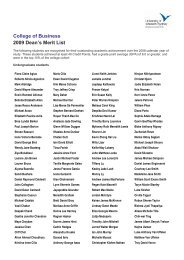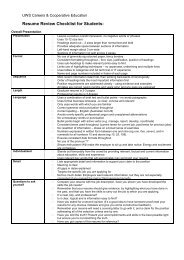Mate-selection and the Dark Triad - University of Western Sydney
Mate-selection and the Dark Triad - University of Western Sydney
Mate-selection and the Dark Triad - University of Western Sydney
Create successful ePaper yourself
Turn your PDF publications into a flip-book with our unique Google optimized e-Paper software.
760 P.K. Jonason et al. / Personality <strong>and</strong> Individual Differences 51 (2011) 759–763People’s personalities allow <strong>the</strong>m to create or ‘‘select’’ <strong>the</strong> environmentsin which <strong>the</strong>y engage (Buss, 1984a, 1987). Individualsmay actively structure <strong>the</strong>ir environment through mate-choice;mate-choice being an important <strong>selection</strong>-domain (Buss, 1984a,1987; Hamilton, 1964). A common effect in mate <strong>selection</strong> is assortativemating – people tend to match <strong>the</strong>mselves up with o<strong>the</strong>rs onspecific characteristics (Buss & Barnes, 1986; Kenrick et al., 1993)like <strong>the</strong> Big Five (Buss, 1984b). The <strong>Dark</strong> <strong>Triad</strong> traits are correlatedwith disagreeableness (Paulhus & Williams, 2002), aggressiveness(Bushman & Baumeister, 1998), criminality (Hare, 1996), <strong>and</strong>manipulativeness (Christie & Geis, 1970) – qualities, we would argue,are directly opposite to kindness. In addition, <strong>the</strong>se individualshave a high need for stimulation (Jones & Paulhus, 2010) <strong>and</strong> risktaking(Jonason, Koenig, & Tost, 2010a; Jonason & Tost, 2010); <strong>the</strong>ymay actually not place a high premium on kindness because <strong>the</strong>ywish to create a volatile environment to stimulate <strong>the</strong>mselves.Therefore, we predict scores on <strong>the</strong> <strong>Dark</strong> <strong>Triad</strong> traits would be negativelycorrelated with preferences for kindness in mates. However,given that psychopathy is correlated with risk-taking above<strong>the</strong> o<strong>the</strong>r traits (Jonason et al., 2010a), we expect this correlationto be localized to psychopathy when we control for variability in<strong>the</strong> o<strong>the</strong>r two.<strong>Mate</strong> <strong>selection</strong> is not a new topic in social-personality psychology.We know that both <strong>the</strong> Big Five <strong>and</strong> <strong>the</strong> sex <strong>of</strong> <strong>the</strong> participantare important variables in underst<strong>and</strong>ing matepreferences <strong>and</strong> <strong>selection</strong>. The <strong>Dark</strong> <strong>Triad</strong> tends to be correlatedwith all parts <strong>of</strong> <strong>the</strong> Big Five (Jakobwitz & Egan, 2006; Paulhus &Williams, 2002), <strong>and</strong> men tend to score higher on <strong>the</strong> threetraits than women do (Jonason & Kavanagh, 2010; Jonason &Webster, 2010; Jonason et al., 2009). In order to avoid <strong>the</strong> ‘‘janglefallacy’’ 1 we checked our results by partialling <strong>the</strong> varianceassociated with <strong>the</strong> sex <strong>of</strong> <strong>the</strong> participant in explaining mate preferences,<strong>and</strong> <strong>the</strong>n partialling <strong>the</strong> variance associated with <strong>the</strong> BigFive in explaining mate preferences in line with prior work (Jonasonet al., 2009).The <strong>Dark</strong> <strong>Triad</strong> traits tend not to be correlated with interestin long-term relationships (Jonason & Webster, 2010; Jonasonet al., 2009). However, human societies are characterized bylong-term mateships, <strong>and</strong> monogamy is held out as a sociallydesirable state <strong>and</strong> is socially enforced to some degree (Kanazawa& Still, 1999; McDonald, 1995). In response to such socioecologicalconditions, individuals who score high on <strong>the</strong> <strong>Dark</strong> <strong>Triad</strong>may still engage in medium- or long-term pair-bonding (Campbell& Foster, 2002). In accordance with prior work (Jonason &Kavanagh, 2010; Jonason et al., 2009, 2010b), we examined <strong>the</strong>manner in which <strong>the</strong> <strong>Dark</strong> <strong>Triad</strong> traits operate in both shortterm<strong>and</strong> long-term contexts. Based on past research on matepreferences <strong>and</strong> recent studies that implicate <strong>the</strong> <strong>Dark</strong> <strong>Triad</strong> asaligned with a short-term mating strategy, we expected st<strong>and</strong>ardsfor short-term mates to be lowest for men scoring higheston <strong>the</strong> <strong>Dark</strong> <strong>Triad</strong>. We also investigated how <strong>the</strong>se traits leadindividuals to structure <strong>the</strong>ir environment to be consistent with<strong>the</strong>ir personality traits in both mating contexts.2.1. ParticipantsTwo hundred <strong>and</strong> forty-two psychology students (108 men; 134women), aged 17–53 years (M = 20.89, Median = 19, SD = 5.33) locatedin <strong>the</strong> Sou<strong>the</strong>rn US received partial course credit for fillingout <strong>the</strong> surveys described below. Ninety-three percent <strong>of</strong> <strong>the</strong> samplewas heterosexual, with 3% homosexual <strong>and</strong> 4% bisexual. Fortysevenpercent <strong>of</strong> <strong>the</strong> sample self-identified as ‘‘single’’ <strong>and</strong> <strong>the</strong>remaining 53% self-identified as ‘‘involved’’ (i.e., married or seriouslydating).2.2. Procedures <strong>and</strong> measuresParticipants completed <strong>the</strong> survey online. Only those participantsfrom unique IP addresses were included to insure <strong>the</strong>assumption <strong>of</strong> independence was not violated. The <strong>Dark</strong> <strong>Triad</strong>‘‘Dirty Dozen’’, a 12-item measure <strong>of</strong> <strong>the</strong> <strong>Dark</strong> <strong>Triad</strong> with four itemsper subscale, was used (Jonason & Webster, 2010). Participantswere asked to what extent <strong>the</strong>y agreed (1 = not at all, 5=verymuch) with statements such as: ‘‘I tend to want o<strong>the</strong>rs to admireme’’; ‘‘I tend to lack remorse’’; <strong>and</strong> ‘‘I have used deceit or lied toget my way.’’ Items were averaged toge<strong>the</strong>r to create an index <strong>of</strong>narcissism (Cronbach’s a = .84), Machiavellianism (a = .86), psychopathy(a = .74), <strong>and</strong> an aggregated index <strong>of</strong> all three (a = .90).The three traits were correlated with one ano<strong>the</strong>r between .49<strong>and</strong> .70 (p < .01). Men scored higher on <strong>the</strong>se measures than womendid on all three dimensions, but <strong>the</strong> sex differences werenot significant. 2To measure <strong>the</strong> Big Five, we used <strong>the</strong> Ten-Item PersonalityInventory (TIPI; Gosling, Rentfrow, & Swann, 2003), which askstwo questions for each dimension. Participants were asked, for instance,how much (1 = not at all,5=very much) <strong>the</strong>y think <strong>of</strong> <strong>the</strong>mselvesas ‘‘extraverted, enthusiastic’’ <strong>and</strong> ‘‘quiet, reserved’’(reverse-scored) as measures <strong>of</strong> extraversion. Estimates <strong>of</strong> internalconsistency returned low rates: extraversion (a = .48), agreeableness(a = .31), conscientiousness (a = .26), neuroticism (a = .31),<strong>and</strong> openness (a = .39), as is to be expected for scales composed<strong>of</strong> a small number <strong>of</strong> items (Kline, 2000); internal consistency estimatesare positively related to <strong>the</strong> number <strong>of</strong> scale items (Carmines& Zeller, 1979). Never<strong>the</strong>less, because we sought tocontrol for variability in <strong>the</strong> Big Five <strong>and</strong> not to directly study <strong>the</strong>Big Five, we proceeded.To measure mate preferences <strong>and</strong> st<strong>and</strong>ards, we used a set <strong>of</strong>traits from previous mate preference papers (Li, Bailey, Kenrick,& Linsenmeier, 2002; Li & Kenrick, 2006; Li, Valentine, & Patel,2011) – social level, creativity, kindness, liveliness, <strong>and</strong> physicalattractiveness (presented in that order, from left to right). For botha long- <strong>and</strong> short-term mate (counterbalanced), participants provided<strong>the</strong>ir minimum accepted decile (10th percentile, 20th percentile,etc.) for each trait by ticking <strong>the</strong>ir answers. Participantswere told to treat each decile as indicative <strong>of</strong> <strong>the</strong> quality <strong>of</strong> a hypo<strong>the</strong>ticalmate. For instance, a mate who was in <strong>the</strong> 10th decile wasin <strong>the</strong> bottom 10% <strong>of</strong> o<strong>the</strong>r potential mates in terms <strong>of</strong> that trait.2. MethodWe examined how men <strong>and</strong> women’s overall st<strong>and</strong>ards forlong- <strong>and</strong> short-term mates related to <strong>the</strong>ir scores on <strong>the</strong> <strong>Dark</strong><strong>Triad</strong>. In addition, we examined correlations between <strong>the</strong> <strong>Dark</strong><strong>Triad</strong> <strong>and</strong> mate preferences where we control for <strong>the</strong> Big Five<strong>and</strong> <strong>the</strong>n <strong>the</strong> sex <strong>of</strong> <strong>the</strong> participant. Last, we tested for moderationby <strong>the</strong> mating context <strong>and</strong> by <strong>the</strong> sex <strong>of</strong> <strong>the</strong> participant.3. ResultsWe first ran a General Linear Model analysis using SPSS withtrait <strong>selection</strong>s as <strong>the</strong> dependent variable. Trait <strong>and</strong> duration (i.e.,long-term, short-term) were within-subjects variables <strong>and</strong> participants’sex was a between-subjects variable. <strong>Dark</strong> <strong>Triad</strong> compositescores were entered as a continuous between-subjects variable(i.e., covariate in SPSS). There was an interaction <strong>of</strong> duration sex <strong>Dark</strong> <strong>Triad</strong> (F(1, 234) = 5.87, p < .05, g 2 p= .02). To inter-1 Introducing a new variable that is a clone <strong>of</strong> ano<strong>the</strong>r (Block, 2000).2 This limitation prohibited us from doing mediation analyses.



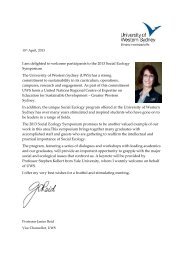
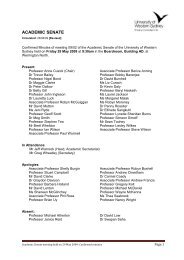
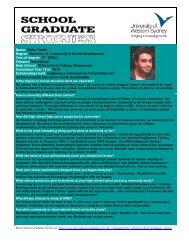
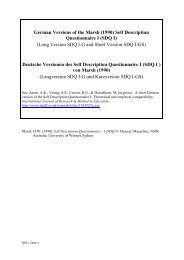
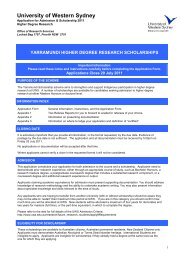
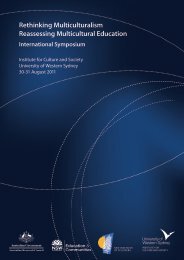

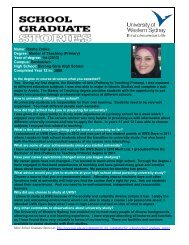
![Glossary of terms for Academic Integration Plans [PDF, 127Kb]](https://img.yumpu.com/46838287/1/184x260/glossary-of-terms-for-academic-integration-plans-pdf-127kb.jpg?quality=85)

